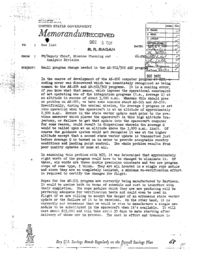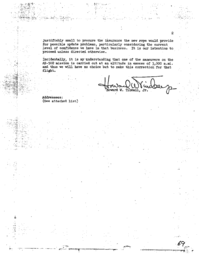Upthread: Ground rules for MIT man loading for AGC programming (Nov 14, 1966)
Downthread: LGC program status for AS-206 (Nov 28, 1966)
See listNOV 25 196666-FM1-168FM/Deputy Chief, Mission Planning and Analysis DivisionSmall program change needed in the AS-501/502 AGC program
In the course of development of the AS-206 computer program at MIT, a coding error was discovered which was immediately recognized as being common to the AS-204 and AS-501/502 programs. It is a scaling error, if you know what that means, which imposes the operational constraint of not operating one of the integration programs (i.e., Average G) at an altitude in excess of about 3,000 n.mi. Whereas this should pose no problem on AS-204, we have some concern about AS-501 and AS-502. Specifically, during the nominal mission, the Average G program is set into operation when the spacecraft is at an altitude of approximately 2,500 n.mi. Errors in the state vector update sent prior to the pre- vious maneuver which places the spacecraft in this high-altitude tra- jectory, or failure to get that update into the spacecraft computer for some reason, could result in dispersions wherein the Average G would be called upon at an altitude above the 3,000 n.mi. limit. Of course the guidance system would not recognize it was at the higher altitude except that a second state vector update is transmitted just before Average G is turned on in order to provide acceptable reentry conditions and landing point control. The whole problem results from poor quality updates or none at all.
In examining this problem with MIT, it was determined that approximately eight words of the program would have to be changed to eliminate it. Of these, six words are three double precision constants and two are program steps of some type, I think. They are all located in a single rope module and since they are so completely isolated, a minimum re-verification effort is required to certify the changes for flight.
Ropes for the AS-501 program are currently being manufactured by Raytheon. It would be unwise both in terms of schedule and cost to interfere with their completion. The rope modules which they are now producing will be perfectly adequate for verification tests and could even be used in flight if we are willing to accept the danger of an erroneous state vector update or the failure of it to be received. On the other hand, it is currently our consensus that we would be wise to manufacture a single new module to be substituted in the spacecraft when it's available. It will cost about $15,000 and will take about 30 days to make starting after delivery of those now in process. The cost in effort and treasure is justifiably small to procure the insurance the new rope would provide for possible update problems, particularly considering the current level of confidence we have in that business. It is our intention to proceed unless directed otherwise.
Incidentally, it is my understanding that one of the maneuvers on the AS-502 mission is carried out at an altitude in excess of 3,000 n.mi. and thus we will have no choice but to make this correction for that flight.
- Jan 08, 1967 – Rope manufacture for AS-502 (3.2σ)


